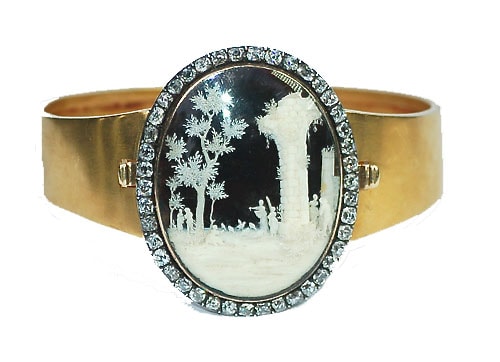Micro-ivory Bangle
High carat gold bangle, circa 1840, containing a virtuoso micro-ivory carving on a black ground, circa 1790, under crystal and within an old-cut diamond surround. A fine example of the delicate, intricate ‘micro-carving’ that was popular within the Kunstkammer of Europe’s nobility in the 18th and 19th centuries. The carvings were executed with such precision that the distance between the leaves of a tree is often no more than a fraction of a millimetre. The carving has many style elements of Stephany and Dresch. G. Stephany and J. Dresch worked in London and Bath in the late 18th century, selling their ivories to members of fashionable English society. They exhibited a number of times at the Royal Academy, and were granted the title, ‘Sculptors in Miniature on Ivory to their Majesties’ by George III. The carving depicts a typical Stephany and Dresch pastoral scene, with a woman and her children feeding chickens in the centre, and couples conversing in a woodland glade and amongst ruins. At the base of the ruins, a branch from a tree has fallen to the ground. Originally a clasp, the micro-ivory and diamond plaque was cleverly converted into a dual functional bangle and pendant in the 1840’s. The bangle can be removed from the plaque which can also be worn as a pendant. The bangle tapers in width from 1 and 1/8 to 1/2 an inch and will fit a wrist of 6 to 7 inches. The diamond and ivory plaque measures 1 and 2/3 by 1 and 1/3 inches. Finely detailed micro-ivory carving, unable ever to be replicated. For similar examples of micro-carvings by Stephany and Dresch, see the British Museum collection and Elfenbeinkunst by P.W. Hartmann.
sold





